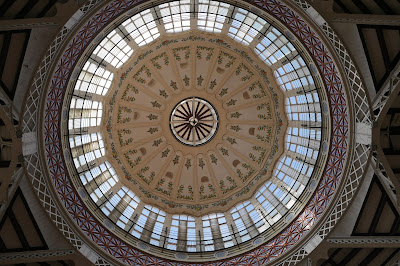Mercado Colon
There are a good number of art nouveau buildings in Valencia, and the scattered houses are described in a separate post. This one focuses on the three big structures which should be high on any visitor's hit list. We started at the Mercado Colon, located off to the south east of the centre quite close to the Calle Colon section of the inner ring road. (Colon of course was the man we call Christopher Columbus.)
The market is a simply wonderful building of red brick with a riot of mosaic, ceramic and stone decorative features. The building was inaugurated on New Year’s Eve 1916 and was designed by City architect of the day, Francisco Mora, who was influenced by the Catalan Modernisme movement of Doménech i Montaner, Puig and Cadafalch.
Here is a closer up picture of the top section of the facade.
It no longer functions as a market and was renovated after having fallen into decline and disrepair. The renovation won a European cultural award in 2003. It now calls itself a Gastro Market and houses a selection of bars and cafes.
In the far corner there is a particularly attractive (and rather Gaudi-esque) wine bar where we enjoyed a leisurely lunch.
Now we headed into the centre of the old city to reach the Mercado Central, which still functions as a food market and is open every morning. It opened in 1928 and its style is less purely art nouveau than that of Mercado Colon and more eclectic. It is a much larger building also and its layout is rather like that of a church with three naves and an apse.
The main market hall is capped by a glass dome.
At the far end there are elaborate decorative tiles, glass and stone work.
All around there stained glass with floral patterns and some rather lovely tiled sunflowers (a classic art nouveau motif).
Now we headed towards the southern end of the old city to reach the third great sight, the Estacion del Norte (North Station, slightly oddly given that it is in the south of the old city). It was built 1907-1917 and the architect was Demetrio Ribes. The main facade is absolutely wonderful.
There are towers to the left and right, which currently highlight the station's 100th anniversary.
A more detailed look at one of the entrance doors reveals beautiful stained glass and fruit motifs.
Inside, the booking hall is a riot of decoration. This lovely sign is at the entrance to the main concourse.
The booking hall roof is held up by these magnificent columns.
Conditions: still hot and sunny.
Distance: only a couple of miles.
Rating: five stars.













No comments:
Post a Comment